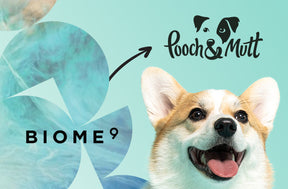
Introducing the BIOME9 × Pooch & Mutt Collaboration
At BIOME9, our mission has always been to push the boundaries of canine gut health research and deliver the best microbiome testing and veterinary support.
Today, we’re excited to announce a new chapter in that journey: a collaboration with Pooch & Mutt.
This fresh new approach will continue to bring accessible, reliable, microbiome testing - paired with the same great supplements and expert advice you trust.












